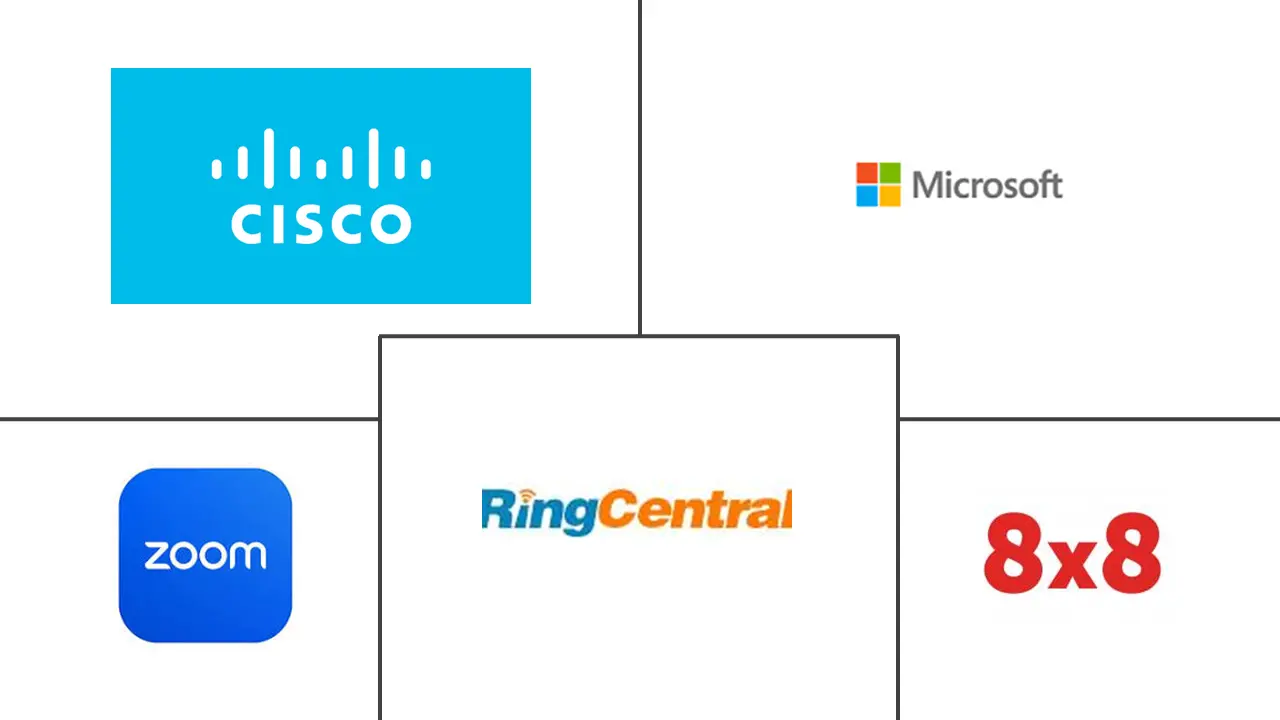
Unified Communication-as-a-Service (UCaaS) Market Analysis by Mordor Intelligence
The UCaaS market is valued at USD 56.14 billion in 2025 and is projected to reach USD 175.83 billion in 2030, advancing at a 25.65% CAGR. The rapid expansion is fueled by enterprise-wide consolidation of fragmented communication tools, measurable ROI from AI-powered productivity functions, and an inflection point in cloud telephony adoption that now extends well beyond basic voice replacement. North American enterprises still account for the largest regional share, yet Asia-Pacific is growing at double-digit rates as 5G networks and mobile-first strategies unlock frontline use cases. Large organizations remain the primary revenue contributors, but cost-sensitive SMEs are embracing pay-as-you-go models that free them from capital outlays while enhancing resilience. Providers that integrate UCaaS with CCaaS and CPaaS are expanding wallet share, and security-driven regional data residency frameworks are becoming a baseline requirement that shapes global roll-outs.
Key Report Takeaways
- By component, telephony retained 38.3% of UCaaS market share in 2024, while collaboration platforms are forecast to post a 28.3% CAGR to 2030.
- By enterprise size, large enterprises held 46.8% revenue share in the UCaaS market in 2024; SMEs are set to expand at a 27.8% CAGR through 2030.
- By end-user vertical, BFSI led with 21.6% of the UCaaS market size in 2024, whereas retail and e-commerce are projected to advance at a 29.1% CAGR to 2030.
- By geography, North America commanded 43.4% of the UCaaS market in 2024, yet Asia-Pacific is expected to grow at a 30.4% CAGR through 2030.
- Microsoft, RingCentral, and Cisco jointly accounted for a combined 58% UCaaS market share in 2024.
Global Unified Communication-as-a-Service (UCaaS) Market Trends and Insights
Drivers Impact Analysis
| Driver | (~) % Impact on CAGR Forecast | Geographic Relevance | Impact Timeline |
|---|---|---|---|
| Pay-as-you-go OPEX model attracts cost-sensitive SMEs | +4.2% | Global; strongest uptake in Asia-Pacific and South America | Medium term (2-4 years) |
| Remote and hybrid work policies stimulate work-from-anywhere demand | +6.8% | North America and Europe lead; global relevance | Short term (≤ 2 years) |
| Integration of UCaaS with CCaaS and CPaaS broadens wallet share | +3.9% | North America and Europe; spreading to Asia-Pacific | Medium term (2-4 years) |
| AI-enabled productivity tools enhance ROI | +5.1% | Developed markets lead; global adoption | Long term (≥ 4 years) |
| 5G-driven mobile UCaaS for frontline workers | +2.7% | Asia-Pacific core; spill-over to North America and EMEA | Long term (≥ 4 years) |
| FedRAMP-grade secure UCaaS opens regulated verticals | +1.8% | United States core; global expansion | Medium term (2-4 years) |
| Source: Mordor Intelligence | |||
Pay-as-you-go OPEX Model Attracts Cost-Sensitive SMEs
Hosted UCaaS solutions let smaller businesses replace capital-heavy PBX systems with predictable monthly fees, yielding up to 55% cost savings over premises-based telephony. SMEs consequently represent the fastest-growing user cohort, posting a 27.8% CAGR from 2024 to 2030. Security matters just as much as cost: 51.3% of SMEs cite cyber protection as their top technology priority, viewing enterprise-grade cloud defenses as superior to in-house safeguards. Uptake is particularly strong in emerging Asia-Pacific and Latin America, where local connectivity partners bundle voice, video, and messaging with 5G mobile access to deliver a fully managed service.
Remote and Hybrid Work Policies Cement Work-from-Anywhere Demand
Hybrid schedules are now permanent, with 91% of employers offering flexible work and 98% of meetings featuring at least one remote participant.[1]Chuck Robbins, “Hybrid Work Is Here to Stay,” Cisco, cisco.com A unified platform that combines voice, video, chat, and file sharing has become mission-critical infrastructure, not a discretionary tool. Employees lose 36 minutes daily when forced to juggle multiple apps, prompting CIOs to consolidate overlapping services. North American enterprises are modernizing outdated meeting rooms with AI-assisted devices that auto-frame speakers and generate live captions, while European firms emphasize privacy-led data handling in compliance with GDPR.
Integration of UCaaS with CCaaS and CPaaS Broadens Wallet Share
Enterprises deploying integrated voice, video, contact-center, and programmable APIs report 53% revenue uplifts and 6% cost reductions relative to siloed environments.[2]John Marlow, “RingCentral Q4 2024 Earnings Call Transcript,” RingCentral, ringcentral.comAPI-ready architectures let mid-sized firms add contact-center functionality without forklift upgrades, fostering sticky multi-year contracts. In the United States, 100% of surveyed IT leaders expect a single-vendor UCaaS-CCaaS environment within 24 months, signaling maturation of the UCaaS market beyond commodity VoIP.
AI-Powered Productivity Features Lift ROI
Real-time transcription, automated summaries, and sentiment analysis transform meeting content into searchable knowledge, saving an average of 10-18 minutes of post-call admin per user.[3]Pure IP Team, “Copilot Integration Brings AI to Teams Calls,” PureIP, pureip.com Voice bots in chain-restaurant roll-outs have captured 30% of previously missed calls and delivered 760% annual ROI, underscoring how AI shifts the UCaaS value proposition from connectivity to performance. Adoption is progressing quickly: 45.8% of enterprises already use AI meeting assistants, a figure forecast to rise to 65.7% by end-2025.
Restraints Impact Analysis
| Restraint | (~) % Impact on CAGR Forecast | Geographic Relevance | Impact Timeline |
|---|---|---|---|
| Skills gap in multi-vendor UC stacks prolongs migrations | −3.4% | Global; most acute in developed economies | Medium term (2-4 years) |
| Rising toll-fraud and SIP trunk breaches inflate TCO | −2.8% | Global; larger risk in regions with weaker cyber laws | Short term (≤ 2 years) |
| Voice-quality variance on public internet links | −1.9% | Rural and emerging markets most affected | Medium term (2-4 years) |
| National data sovereignty constraints | −2.1% | Europe and Asia-Pacific primarily | Long term (≥ 4 years) |
| Source: Mordor Intelligence | |||
Skills Gap in Multi-Vendor UC Stacks Prolongs Migration Cycles
Enterprises cite a lack of cloud-native voice engineers and API integration specialists as the main impediment to migration, with 62% of IT leaders reporting delays.[4]Satya Nadella, “Microsoft FY 2024 10-K,” Microsoft, microsoft.com Larger organizations struggle to mesh legacy PBX, SIP trunking, and new AI services without downtime, forcing reliance on costly systems integrators. This bottleneck is particularly visible in banking and healthcare, where security scrutiny extends project timelines.
Rising Toll-Fraud and SIP-Trunk Security Breaches Inflate TCO
Telecom fraud now drains USD 28.3 billion annually, placing UCaaS cost advantages at risk. In a well-publicized case, a mid-size architectural firm lost USD 166,000 to fraudulent international calls after attackers manipulated SIP credentials. Security measures such as session border controllers, multi-factor authentication, and call-anomaly detection add expense and complexity, yet remain mandatory for mission-critical roll-outs.
Segment Analysis
By Component: Collaboration Platforms Challenge Telephony Dominance
Telephony accounted for 38.3% of UCaaS market share in 2024, yet collaboration platforms are growing at a 28.3% CAGR, echoing the pivot from stand-alone voice to integrated video, chat, and content sharing. Unified messaging and multi-party conferencing tools secure ongoing budget priority as CIOs seek productivity gains. Investments flow toward AI-enhanced features such as live translation, real-time whiteboarding, and automated action tracking that convert meetings into corporate knowledge.
The UCaaS market size for collaboration platforms is forecast to reach USD 82 billion by 2030, reflecting adoption across all verticals. Telephony remains essential for regulated call recording and emergency services, but commoditization pressures persist. Vendors differentiate via embedded analytics, guaranteed quality-of-service, and regional data residency that satisfy public-sector requirements.
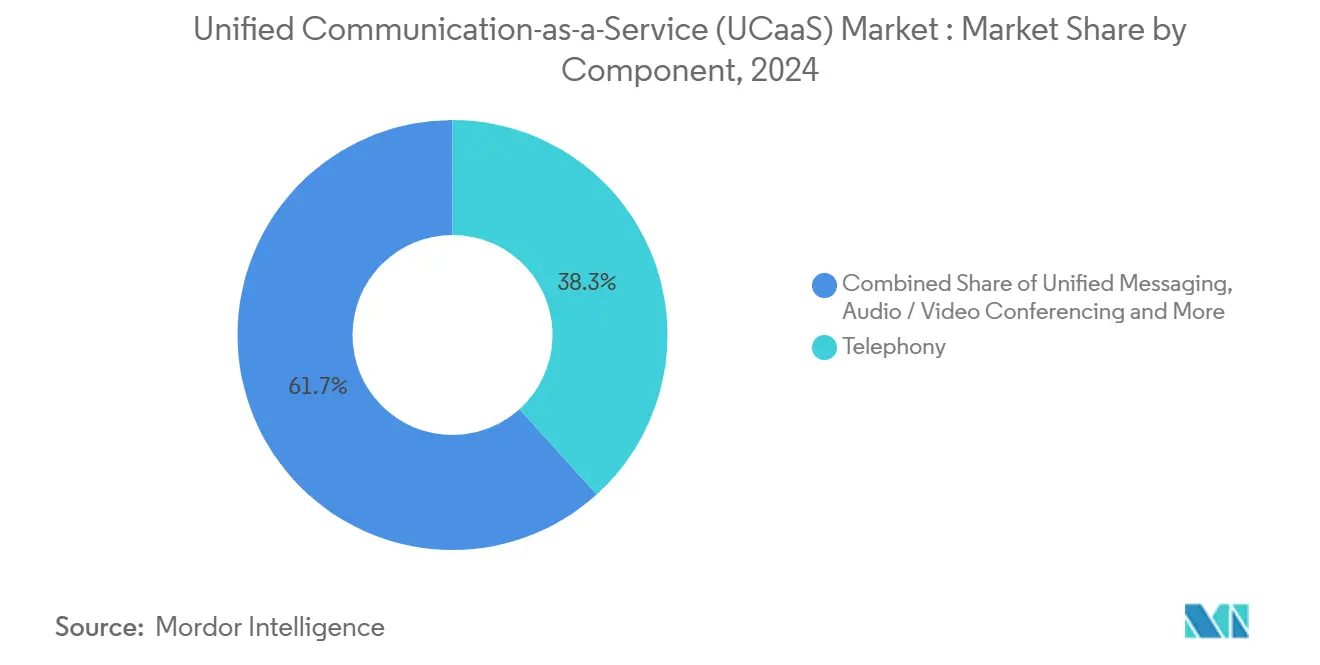
Note: Segment shares of all individual segments available upon report purchase
By Enterprise Size: SMEs Drive Growth Despite Large-Enterprise Dominance
Large organizations held 56.8% of 2024 revenue, yet SMEs represent the most dynamic demand pool, expanding at 27.8% CAGR. Cloud economics enable smaller firms to access enterprise-grade voice, video, and omnichannel services without capital investment. Security priorities remain top-of-mind: 51.3% of SMEs allocate more than one-fifth of IT budgets to cyber controls and prefer providers that bundle advanced threat protection.
The UCaaS market size for SMEs is projected to exceed USD 64 billion by 2030. In contrast, Fortune 500 adoption focuses on complex global roll-outs, integration of legacy PBX estates, and data sovereignty compliance in jurisdictions such as Germany and Japan. Managed service providers that offer 24/7 support and expertise in multi-tenant architecture are gaining traction among resource-constrained IT departments.

Note: Segment shares of all individual segments available upon report purchase
By End-User Vertical: Retail Transformation Accelerates Beyond BFSI Leadership
BFSI contributed 21.6% of 2024 revenue on the back of compliance needs, secure recording, and high-touch client interactions. Retail and e-commerce, however, are on track for a 29.1% CAGR as omnichannel strategies demand unified voice, chat, and social engagement. Logistics tracking, curbside pick-up, and click-and-collect workflows depend on real-time communication between consumers, store staff, and supply-chain partners.
The UCaaS market size for retail is anticipated to reach USD 36 billion by 2030, while healthcare, government, and manufacturing continue to adopt industry-specific UCaaS packages that address HIPAA, FedRAMP, and mission-critical uptime. Mobile endpoints equipped with 5G connectivity enable clinicians, field engineers, and warehouse employees to collaborate without desk phones, demonstrating how vertical nuances shape product roadmaps.
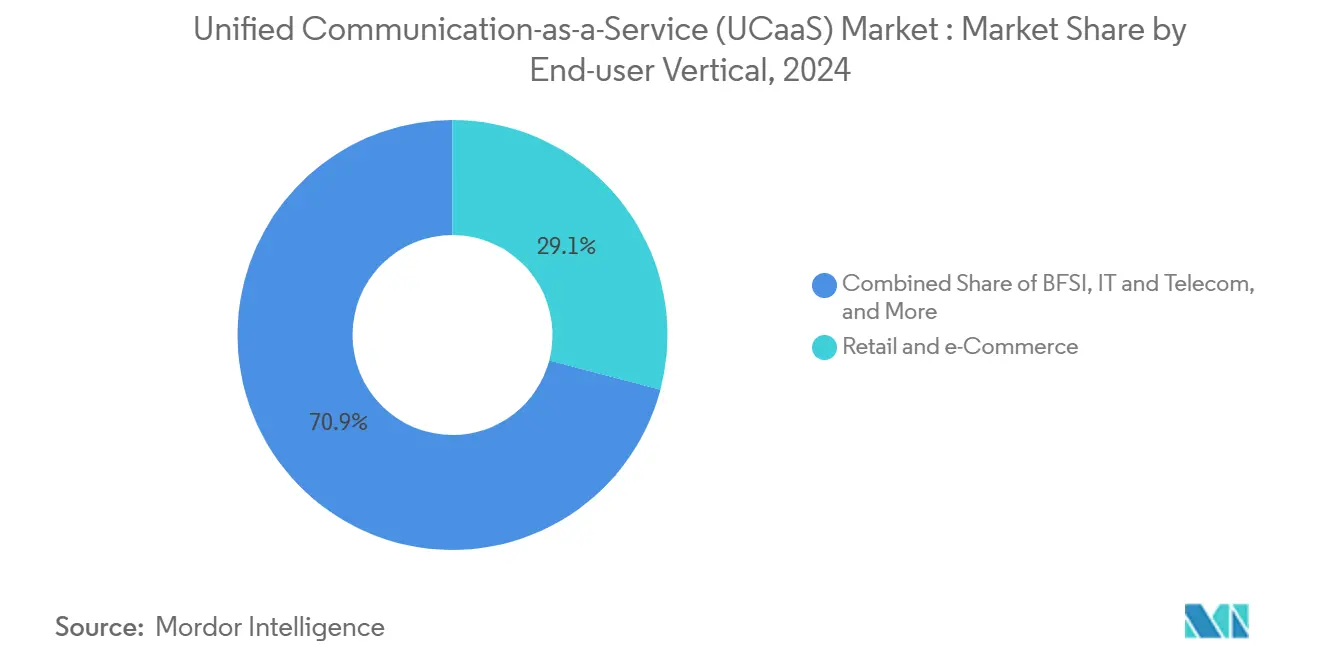
Note: Segment shares of all individual segments available upon report purchase
Geography Analysis
North America led the UCaaS market with 43.4% revenue share in 2024 thanks to widespread cloud maturity, robust broadband infrastructure, and entrenched Microsoft Teams deployments. The United States further benefits from FedRAMP-certified offerings that unlock public-sector contracts. Growth is slowing to low-double digits as penetration nears saturation, yet AI integration, contact-center convergence, and frontline worker solutions keep spending momentum intact.
Europe follows with steady uptake in the United Kingdom, Germany, and France. GDPR, the Digital Markets Act, and impending national cloud regulations prompt enterprises to favor providers with local data centers and cross-platform interoperability. Independent service providers gain share by tailoring solutions to linguistic requirements and vertical compliance rules, especially in health and public administration.
Asia-Pacific delivers the strongest trajectory at a 30.4% CAGR through 2030. National 5G coverage, mobile-only workforces, and government-sponsored digital agendas propel adoption in Japan, South Korea, Singapore, and Australia. Southeast Asian nations are leapfrogging fixed-line limitations, with cloud-native UCaaS meeting multilingual needs and price points for SMEs. The UCaaS market size in Asia-Pacific is forecast to match North America by 2030 if current momentum continues. Latin America and the Middle East and Africa trail but show rising opportunity through fiber and 4G/5G roll-outs that lower access costs for cloud communications.
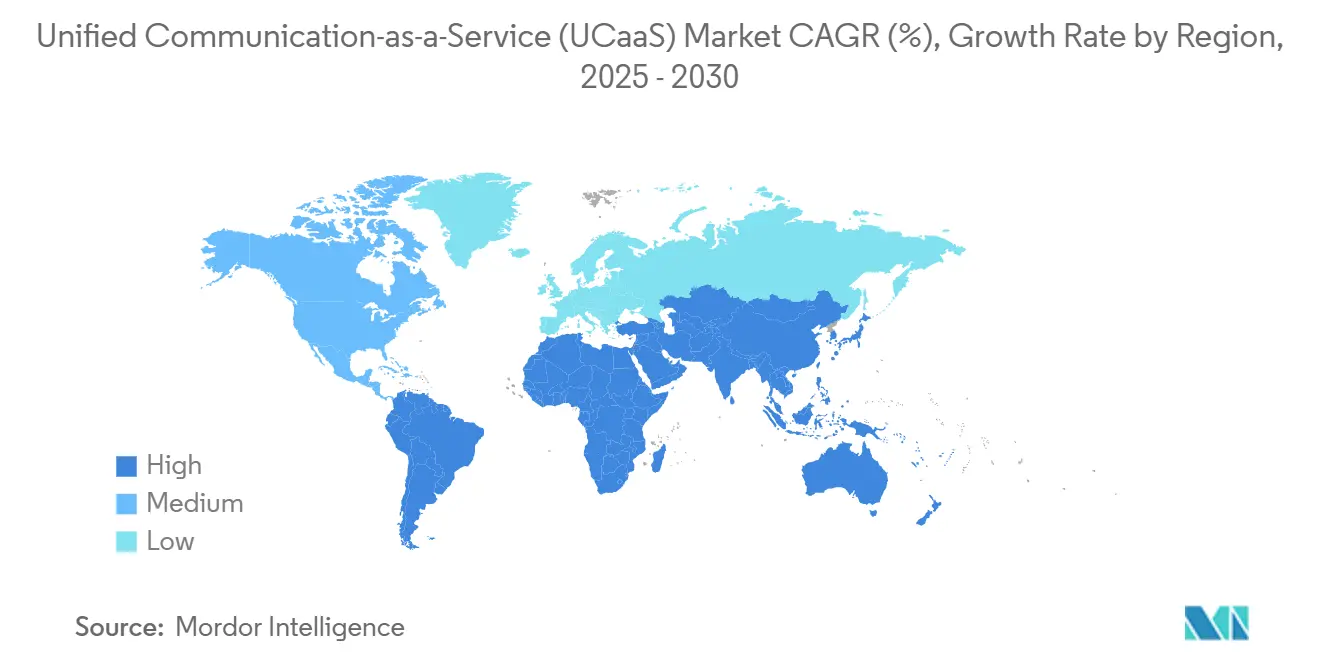
Competitive Landscape
Competition centers on platform breadth, AI differentiation, and compliance-driven data residency. Microsoft continues to convert Office 365 subscribers to Teams Phone licenses, reinforcing productivity suite lock-in. RingCentral holds 20% global UCaaS market share and recorded USD 612 million in quarterly revenue, powered by RingSense AI that automates meeting insights. Cisco, Zoom, and 8x8 emphasize openness through APIs and contact-center modules that embed chatbots and sentiment analytics.
Telecom incumbents such as Verizon, BT, and Deutsche Telekom exploit network assets to guarantee voice quality and bundle SD-WAN, security, and mobility. New entrants leverage 5G edge computing to deliver mobile-first experiences aimed at logistics, manufacturing, and field services. Consolidation is under way: Ericsson’s acquisition of Vonage re-aligns enterprise and carrier ecosystems, while Mitel’s purchase of Unify elevates its installed base past 75 million users. Partnerships with hyperscalers expand global reach as providers deploy regional PoPs to comply with data-sovereignty statutes.
Vendor strategies reflect three imperatives: integrate UCaaS with CCaaS and CPaaS to capture larger budgets; embed AI that yields tangible productivity metrics; and maintain regional compliance certifications ranging from FedRAMP High to IRAP and ENS. Firms meeting these benchmarks are best positioned to ride sustained double-digit UCaaS market growth.
Unified Communication-as-a-Service (UCaaS) Industry Leaders
-
8X8 Inc.
-
Cisco Systems Inc.
-
Zoom
-
RingCentral
-
Microsoft
- *Disclaimer: Major Players sorted in no particular order
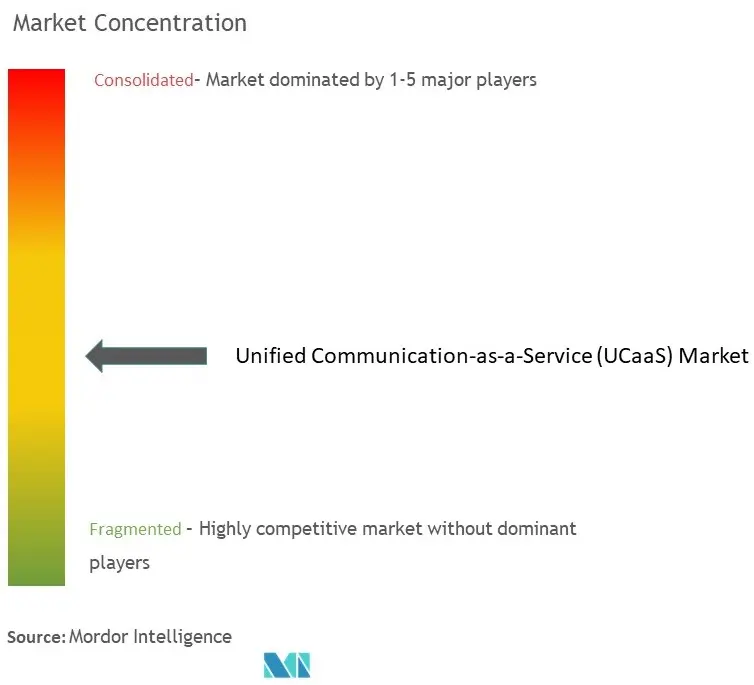
Recent Industry Developments
- June 2025: Mitel finalized the takeover of Unify, creating the second-largest unified communications provider with more than 75 million users worldwide.
- May 2025: Avaya and RingCentral deepened their partnership by embedding RingSense AI into hybrid deployments spanning on-premises and public cloud environments.
- March 2025: Cox Business and RingCentral announced an alliance to combine high-speed connectivity with AI-powered UCaaS, including contact-center expansion later in the year.
- January 2025: Ericsson closed its USD 6.2 billion acquisition of Vonage, integrating 5G cellular capabilities with cloud communications to accelerate enterprise application innovation.
Research Methodology Framework and Report Scope
Market Definitions and Key Coverage
Our study defines the Unified Communications-as-a-Service (UCaaS) market as cloud-native platforms that integrate enterprise telephony, video and audio conferencing, real-time messaging, file sharing, and basic contact-center functions under a single subscription, delivered over public or private internet backbones.
Scope exclusion: Hardware endpoints, on-premises PBX software, and stand-alone collaboration apps without voice workloads sit outside our coverage.
Segmentation Overview
- By Component
- Telephony
- Unified Messaging
- Audio / Video Conferencing
- Collaboration Platforms
- By End-user Enterprise Size
- Small and Medium Enterprises
- Large Enterprises
- By End-user Vertical
- BFSI
- Retail and e-Commerce
- Healthcare and Life Sciences
- Government and Public Sector
- IT and Telecom
- Education
- Others (Manufacturing, Hospitality, etc.)
- By Geography
- North America
- United States
- Canada
- Mexico
- South America
- Brazil
- Argentina
- Rest of South America
- Europe
- Germany
- United Kingdom
- France
- Italy
- Russia
- Spain
- Switzerland
- Rest of Europe
- Asia-Pacific
- China
- India
- Japan
- South Korea
- Malaysia
- Singapore
- Vietnam
- Indonesia
- Rest of Asia-Pacific
- Middle East and Africa
- Middle East
- Saudi Arabia
- United Arab Emirates
- Turkey
- Rest of Middle East
- Africa
- Nigeria
- South Africa
- Rest of Africa
- Middle East
- North America
Detailed Research Methodology and Data Validation
Primary Research
Interviews with CIOs, telecom carriers, and regional system integrators across North America, Europe, Asia-Pacific, and the Gulf provided insights on contract sizes, migration pipelines, and churn triggers, which we then used to validate cost per seat assumptions and forecast adoption waves.
Desk Research
We began by mapping the active user universe through public datasets such as Federal Communications Commission VOIP subscription filings, the International Telecommunication Union's ICT indicators, Eurostat enterprise cloud adoption tables, and OECD remote-work statistics. Trade bodies (for example, the Cloud Communications Alliance) and quarterly disclosures in SEC 10-Ks helped clarify seat counts and pricing corridors. To benchmark vendor revenues, our analysts pulled curated company snapshots from D&B Hoovers and filtered news flows on Dow Jones Factiva. Many other open publications were also reviewed; the list above is illustrative, not exhaustive.
Market-Sizing & Forecasting
A top-down installed-base rebuild starts with counted knowledge-worker populations by country, applies serviceable-addressable-market filters (broadband readiness, compliance constraints), and multiplies the resulting seat pool by UCaaS penetration rates gathered from primary calls. Results are cross-checked with selective bottom-up indicators such as vendor revenue splits, partner channel checks, and sampled average selling price × seats. Key variables feeding the model include remote/hybrid workforce share, average cloud telephony price per user per month, ISP bandwidth growth, merger activity of regional carriers, and regulatory pushes toward PSTN switch-off. Forecasts to 2030 are generated through multivariate regression where penetration, seat price, and GDP-per-capita act as leading inputs, after which scenario analysis adjusts for recession or policy shocks. Data gaps in long-tail geographies are bridged using regional proxies that are later stress-tested with experts.
Data Validation & Update Cycle
Before sign-off, a second analyst audits variance against historical revenue trends and independent telecom traffic statistics. Models refresh yearly, and we trigger mid-cycle updates when material events (major vendor mergers, abrupt pricing shifts) move the baseline.
Why Mordor's Unified Communication-as-a-Service Baseline Commands Reliability
Published numbers differ because firms pick divergent scopes, adoption curves, and refresh cadences. We anchor ours on the addressable knowledge-worker seat pool and current live subscriptions, which gives buyers a directly traceable starting point.
Key gap drivers are often hidden in competitors' assumptions; some fold broader Unified Communications hardware into UCaaS, while others layer aggressive price-erosion curves or apply dated exchange rates. Our analysts revisit variables every twelve months, so currency and seat-price inputs stay contemporary.
Benchmark comparison
| Market Size | Anonymized source | Primary gap driver |
|---|---|---|
| USD 56.1 B | Mordor Intelligence | - |
| USD 87.4 B | Global Consultancy A | Includes on-premises UC seats and combines conferencing software revenues |
| USD 70.5 B | Regional Consultancy B | Uses list prices without regional discounting and applies a uniform 18 % CAGR |
| USD 56.8 B | Industry Association C | Counts only public-cloud deployments, omitting private-cloud seats |
The comparison shows that once differing scopes and pricing logics are stripped out, Mordor's disciplined seat-based calculus presents a balanced, transparent baseline that decision-makers can confidently reference.
Key Questions Answered in the Report
What is the projected CAGR for the UCaaS market between 2025 and 2030?
The UCaaS market is forecast to grow at a 25.65% CAGR from 2025 to 2030.
Which region will grow the fastest in the UCaaS market over the next five years?
Asia-Pacific is expected to post a 30.4% CAGR through 2030, outpacing North America and Europe.
Why are SMEs adopting UCaaS solutions so quickly?
SMEs favor pay-as-you-go pricing that removes capital expenses, delivers enterprise-grade security, and supports mobile workforces without on-site PBX hardware.
How does AI enhance the value proposition of UCaaS offerings?
AI automates meeting transcription, summaries, and sentiment analysis, reducing admin tasks by up to 18 minutes per meeting and improving ROI.
What are the main security risks associated with UCaaS deployments?
Key risks include toll-fraud, SIP credential theft, and regional data-sovereignty mandates that require secure, compliant hosting.
Page last updated on:
